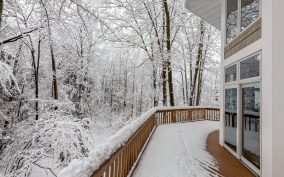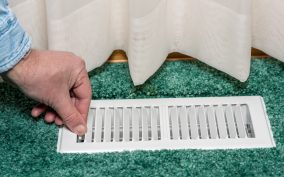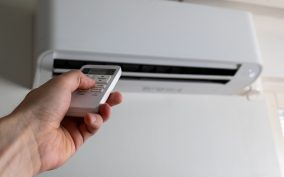Apr 8 2025
How to Protect Your HVAC System from a Natural Disaster
Natural disasters can wreak havoc on homes and communities, and the Midwest is no stranger to their devastating impact. With over 1,500 tornadoes recorded in Indiana since 1950, the importance of protecting your home from these forces of nature cannot be overstated. While homeowners often focus on safeguarding their roofs, windows, and basements, your HVAC system is just as critical. It’s an investment that provides year-round comfort, and protecting it during a disaster is essential.
At Van Drunen Heating & Air Conditioning, we’ve spent over 50 years helping homeowners maintain and safeguard their HVAC systems. Below, we’ll guide you through everything you need to know to protect your heating and cooling system before, during, and after a natural disaster.
Understanding The Vulnerability of Your HVAC System
Your HVAC system is composed of complex parts that can be easily damaged in extreme weather conditions. Here are the most vulnerable components to be mindful of:
- Outdoor Units: These units are highly exposed to wind, rain, debris, and flooding. Strong winds can dislodge them or damage their internal mechanisms, while debris and water can cause irreparable harm.
- Electrical Systems: The electrical components in your HVAC system are especially susceptible to power surges or water damage, which could result in short-circuiting or system failure.
- Air Ducts: Floodwaters or flying debris can clog or damage your air ducts, compromising airflow and reducing efficiency after a disaster.
- Condenser Coils: Dirt, debris, or falling branches can damage these delicate parts, reducing the efficiency of your system and requiring costly repairs.
Knowing which parts of your HVAC are at risk can help you focus your efforts and resources when preparing your system for a storm or other natural disaster.
Preparing for Natural Disasters
Preparation is your best defense against potential HVAC damage. Here are steps you can take to safeguard your system:
1. Schedule Regular Maintenance
Routine maintenance is crucial for keeping your HVAC system in top shape year-round, ensuring it’s ready to withstand extreme conditions. Regular tune-ups from a trusted professional can identify vulnerabilities and fix potential issues before they become costly problems.
2. Elevate Outdoor Units
If you live in a flood-prone area, ensure your outdoor HVAC unit is elevated on a concrete platform or patio stones. This small step can protect it from standing water, which can cause motor and electrical damage.
3. Clear the Surrounding Area
Check the area around your outdoor unit and remove items that could turn into projectiles during high winds, such as lawn furniture, potted plants, grills, or loose tools. Ensuring nothing is nearby is one of the simplest ways to protect your unit.
4. Install Protective Gear
Consider installing tornado straps to anchor your HVAC system securely to its base. You might also cover exposed units with weather-resistant tarps that can shield them from flying debris and heavy rain.
5. Invest in Surge Protection
Power surges are common during storms and can severely damage your HVAC system’s electrical components. Installing a whole-house surge protector or dedicated surge protection for your HVAC system can help mitigate this risk.
Protecting Your HVAC System During a Disaster
While preparation is crucial, there are also important steps to take during a disaster to minimize the risk of HVAC damage:
1. Turn Off Energy Supplies
Before a storm hits, cut the power supply to your HVAC system by flipping the circuit breaker. This reduces the risk of electrical damage from power surges or flooding.
2. Monitor Weather Alerts
Stay aware of current weather conditions to make decisions about additional measures, such as covering your outdoor unit with a tarp or even disconnecting certain components if safe to do so.
3. Stay Clear of Water-Damaged Units
Floodwaters in your home or yard could endanger your HVAC system. Never attempt to restart or interact with an HVAC system that has been submerged until a professional has inspected it.
After the Disaster: Assessing and Restoring Your HVAC System
When the storm has passed, your priority will be to assess and repair any damage to your HVAC system. Here’s how to do it safely and effectively:
1. Inspect the System Carefully
Walk around your home and check for visible damage to both indoor and outdoor units. Look for:
- Water damage or flooding near the unit.
- Signs of electrical damage, such as burned wires or tripped circuits.
- Buildup of debris around the unit.
2. Call a Professional for Inspection
If your HVAC system has experienced any damage—whether obvious or subtle—it’s essential to have a licensed technician assess the extent of the damage. They can provide expert recommendations for repair or replacement.
3. Avoid DIY Repairs
It may be tempting to tackle small fixes yourself, but HVAC systems have intricate components that require professional handling. Repairs done incorrectly could lead to further damage or void manufacturer warranties.
Invest in Proactive Protection for Peace of Mind
Natural disasters are unpredictable, but with proper planning, you can minimize the impact they have on your home and HVAC system. By understanding your system’s vulnerabilities, taking preventative measures before disasters strike, and working closely with professionals, you can protect your system and save money on avoidable repairs.
If you’re looking for an experienced team to help you prepare, inspect, or restore your HVAC system, contact Van Drunen Heating & Air Conditioning today. With over 50 years of expertise, we’re here to keep your system working seamlessly through every season—no matter what nature has in store.




